Hard mattresses
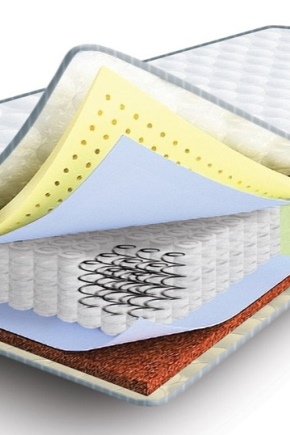
The dream of a modern person should not only be comfortable. It is important that along with muscle relaxation and recuperation, the body is in the correct position and the spine is supported. Only hard mattresses can properly organize sleep. They stand out from their counterparts in a number of differences.
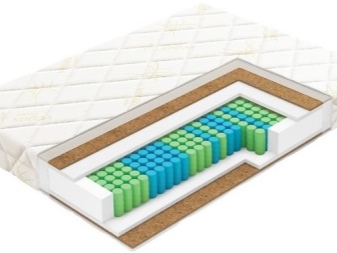
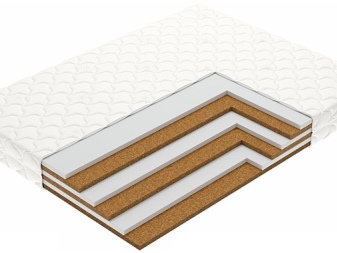
Feature, pros and cons
Hard mattresses are the only mats that can make a person's rest not only comfortable, but also correct. Unlike analogs of a soft structure, such mattresses exclude unnatural bends of the spine during sleep, which is very harmful to health.

Hard mattresses are not wooden structures at all, as many people mistakenly believe. In fact, such mats are blocks with a special orthopedic padding that, with a rigid base, can provide the user with complete muscle relaxation, reduce the load on the spine, and relieve pain in the back, lumbar region and neck. Such blocks are recognized as an excellent prevention of diseases of the musculoskeletal system. If you sleep on hard mattresses and perform a set of special exercises prescribed by an orthopedic doctor, you can gradually get rid of scoliosis, poor posture, and headaches.
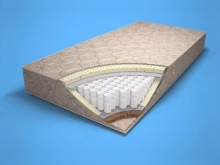
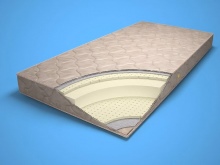
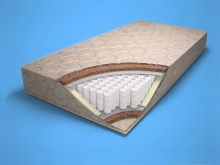
Rigid mats have a number of features. They:
- are made from raw materials of natural and synthetic origin;
- depending on the type of construction, they have a different structure and block thickness;
- provide a sleeping place with a perfectly flat surface;
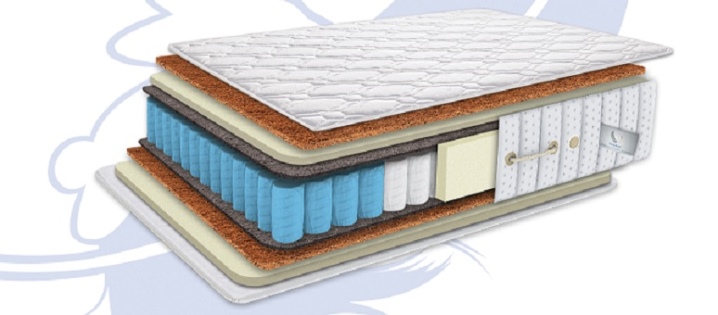
- differ in the degree of rigidity, allowing you to choose an option, taking into account the doctor's recommendations or your own preferences;
- can be one-sided or two-sided, with a different effect on each side;
- designed for users of different ages (from infants to the elderly);
- imply a different weight load, taking into account the size of the bed and the number of berths;
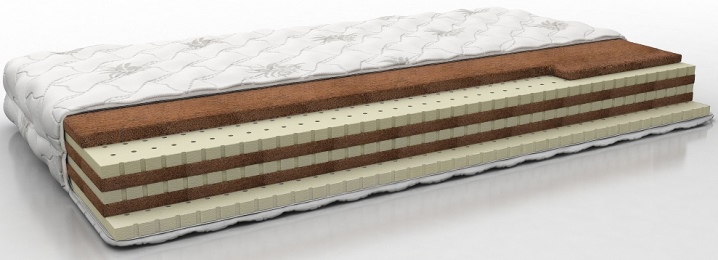
- differ in different block shapes (standard and non-standard);
- are made in a mass and individual way (to order for specific measurements and shape of the bed);
- based on the components of the block, they differ in different costs.
Despite the fact that hard mattresses are the best types of bed units, they are gentle to use. You cannot jump or jump on them: the padding of the block may break, since it is not elastic. When buying such a block for children, you need to take into account the child's activity, trying to prevent breakage.
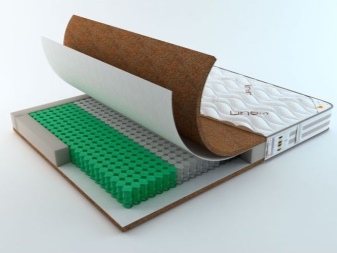
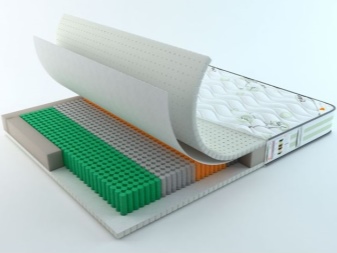
In addition, the permissible load must not be exceeded: such models are not suitable for people with excess weight. First, placing an overweight user on such a mattress will be uncomfortable and painful. Secondly, under the weight of an overweight body, the block may break. Another disadvantage is the limitation of the use of hard mattresses for the elderly. Softer designs are recommended to such buyers.
Varieties
By the type of structure, hard mattresses are of two types:
- monolithic;
- combined.
The first type is a cast plan construction of a single rigid fiber, dressed in a textile cover. These are the toughest mats that do not have an additional softening layer of padding. Combined type options are more varied... They have a different base, however, they are always supplied with additional packing (in one or several layers) to give the required degree of rigidity to the structure.
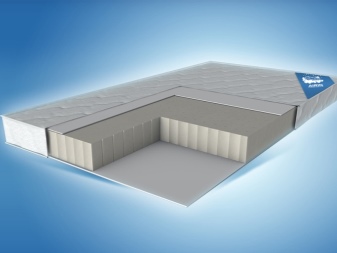

By the type of base, hard mattresses are divided into:
- spring;
- springless.
Each variety has its own characteristics, pros and cons. In any of the categories, you can choose truly high-quality and practical models with the necessary orthopedic effect. And in one, and in another case, a special filling is used in hard mattresses, which determines the basic properties of the block, its durability and practicality.



Features of springless mattresses
Springless rigid mats are orthopedic block types. There are no stretchable metal elements in them, so the surface will always be unchanged, not subject to deformation. Such mattresses are often made from hypoallergenic natural raw materials, so they do not cause negative skin sensations (irritation, itching, redness). In most products, they are very elastic, have good air exchange, which excludes the formation of an environment for the development of fungus, mold and decay.

These blocks are environmentally friendly and safe to use. Due to the fact that there is no metal in them, they do not accumulate static electricity, do not irritate with a squeak, and are safe for humans (which is especially important when choosing a model for children). Another advantage is resistance to odor and moisture absorption. They dry quickly in a natural way and are designed for long-term use (10 - 15 years).
Models made from natural stuffing are more perfect: they do not emit toxic substances, and therefore eliminate the discomfort associated with the appearance of headaches and shortness of breath.
The only thing that is important to consider when choosing such blocks is the composition of the adhesive component (natural resin is preferable instead of rubber), then the sleep will be full.

The most correct stuffing of hard mats is coconut coir. It is made from the skin of a coconut by soaking, combing and processing. In addition to the fibrous substance, manufacturers use coconut flakes or the needle-punched method of assembling the mat, when the raw material is attached to a woven base. However, if you need a quality coconut mat, you should opt for a fiber impregnated with latex to maintain its shape.
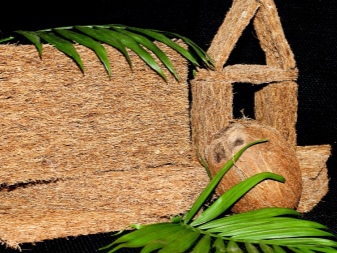
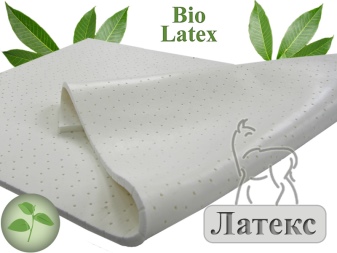
An equally good type of filler for rigid blocks is natural or synthetic latex. The natural type of filling is obtained in the process of processing Hevea tree sap (it grows in the tropics), the synthetic filler is its analogue, not so elastic, but rather tough. By its structure, latex is a porous block with apertures in the form of cells, differing in different depths and diameters. Such filler is somewhat softer than coir; it has different levels of hardness in all zones of the block. This contributes to an even distribution of the body's load without harm to health.

Spring mattresses, although considered orthopedic, actually have an orthopedic effect only under certain conditions. It does not matter for which bed they are bought (single or double), the main thing is that their design consists of small double springs and is of an independent type. This means that the mesh should consist of more than 1000 vertical twisted elements. for 1 sq. m, and it is better if the springs are double: each of them is inserted into another, of a smaller diameter ("Multipack" and "Micropack"). The design feature is that each spring is packed in a breathable textile cover. The covers are interconnected to maintain the integrity of the frame.
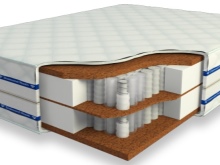
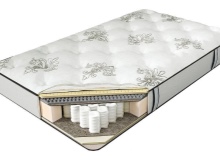
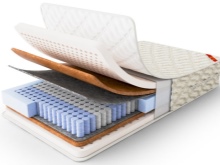
With pressure on a mat of this type, only the outer springs work, and the inner ones are connected exclusively with increased pressure on the mattress. Due to this feature, the position of the spine is correct, and thanks to the rigid layer of additional padding, the orthopedic effect is maintained.The structure of such a block is as follows: the core consists of a large number of springs, they are covered with coir or latex, a layer of holofiber, struttofiber, spandbond, felt or polyurethane foam is added on top. These mattresses are softer than springless mattresses, so in some cases they are suitable as a block on a bed for the elderly. As for children, such models cannot be bought either in a cradle or in a crib, even if the springs are very small and covered with a thick layer of coconut.


Degrees of hardness
Despite the fact that mattresses are called hard, their degree of hardness is ambiguous. In total, there are three levels of mattress firmness:
- soft;
- moderately hard;
- tough.

Soft variants do not fall into the group of hard blocks. They come on a spring or springless basis, however, they do not provide adequate support for the spine, sag under the weight of the weight and curl posture day after day while a person sleeps. The only obstacle to harm to human health in such blocks is the slats located at the base of the bed. They are lattice beams made of wood, spaced at the same distance from each other.
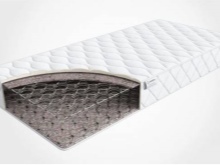


Medium hardness mattresses differ from very hard blocks, they are considered the golden mean, versatile, designed for an average weight of one or two users, suitable for healthy and sick people, and are not limited in age categories. Products of high rigidity are selected for medical reasons. Despite the seeming unsuitability for sleep, such designs are convenient and relevant, especially in childhood. For example, they help shape the posture of a newborn whose spine does not yet have the necessary curves. If we compare them with ordinary spring mattresses, then the second type will disrupt the development of posture: the baby's back will not be able to relax overnight and will bend day after day.
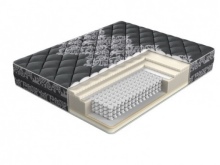
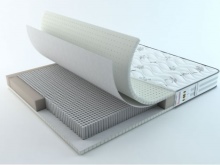
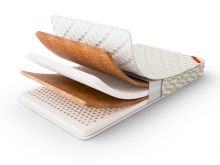
One of the types of rigid mats is a design with different stiffness of berths. These mattresses are designed for two partners with different weights.... Their difference is the different method of filler composition. At the same time, the block does not lose its qualities and service life. As a rule, in such a block there is always a rigid (orthopedic) base and there is an additional layer of a different thickness necessary to support the spine.
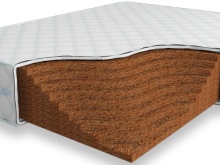
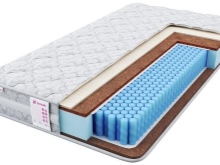
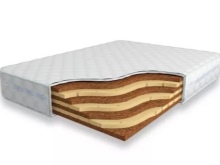
If we compare the stiffness of spring and springless blocks, then the most rigid ones are precisely the latter. You can't just pick up and buy a hard mattress without special recommendations, based only on the opinion of the seller. In some cases, such models really help health, in others they can exacerbate the problem. For example, in case of osteochondrosis, it is preferable to replace such mattresses with moderately hard ones.

Dimensions (edit)
The sizes of hard mattresses do not differ from all existing analogues. They are made for standard bed sizes for children, one or two adults. Therefore, the parameters of the mat can be small, medium or large, as well as non-standard (round, square).
It is worth noting that each manufacturer sets their own furniture standards, so the size of the mattresses may vary. Usually, the parameters are indicated in centimeters, although some companies use the millimeter measurement system (for example, 1200 by 1800, 2000 by 2000 mm). Children's models are 50x60, 100x60, 120x60 cm. The smallest are designed for a stroller or cradle. For preschool children and adolescents, companies produce models with dimensions of 140x70, 80x150, 70x160, 80x160 cm.

Options for high school students and adults are large in length and width. Based on the number of sleeping places, they can be 90x190, 140x190, 75x195, 80x200, 90x200, 200x120, 140x200, 160x200, 180x200. Models with a size of 190x140 cm and more are suitable for full double beds.Spacious mattresses for a family of three are even larger: 200x200, 210x200, 210x240 cm.
Selection Tips
It is immediately worth understanding that the choice of a hard mattress is individual: for a particular person you need to purchase your own mattress. This may not be the first option you like, since each person's health is different. The choice is made thoroughly, taking into account all the nuances:
- before buying, you need to look at the information about the models on the manufacturers' websites, taking into account the dimensions in accordance with the weight and the number of berths;
- in the store it is worth making sure of the quality of the goods by asking for a certificate and learning the terms of the guarantee;
- the high-quality mattress has a removable cover with a zipper, thanks to which you can open the structure, determine the rigidity and structure of the block;
- if there is a dark brown coir inside the coconut mat, impregnated with natural resin or latex, this is a good mattress that will last long enough;
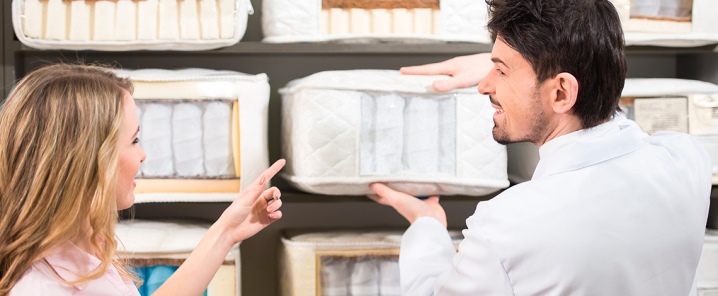
- a pale shade of coir indicates an immature fiber, which will reduce the service life, affecting the quality of the block;
- the size of the mattress should ideally fit into the frame of the bed (if it is larger, it will begin to bend, deforming the surface of the sleeping place and harming the spine);
- if you need an orthopedic mattress to prevent problems of the spine and back, you should pay attention to a springless block made of latex or coir of a combined type or a two-sided winter-summer model (with a warm layer on one side and cotton on the other);
- in choosing the degree of rigidity, the rule should be taken into account: the less the weight, the less the density of the sleeping place (does not apply to children and the prevention of back diseases);
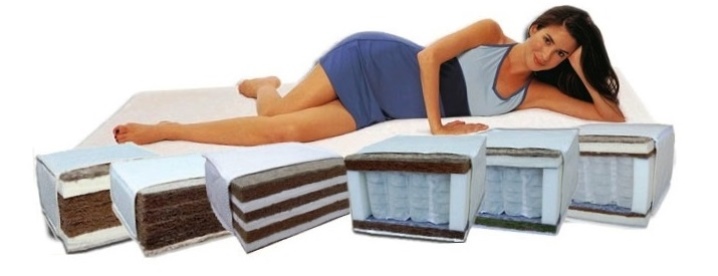
- older people after 50 are not recommended constructions of high rigidity due to the weakening of the muscles that support the spine;
- in case of pain in the spine, you need to consult a doctor: usually such users are not recommended too hard mattresses (the best option for a block for them is a latex version of moderate hardness);
- with osteochondrosis, intervertebral hernia, improper posture and problems of the upper spine, you should pay attention to rigid structures on a spring or medium stiffness on a springless basis;
- Exceptionally springless firm mattresses made of coconut fiber are relevant for children: they provide a comfortable position during sleep.
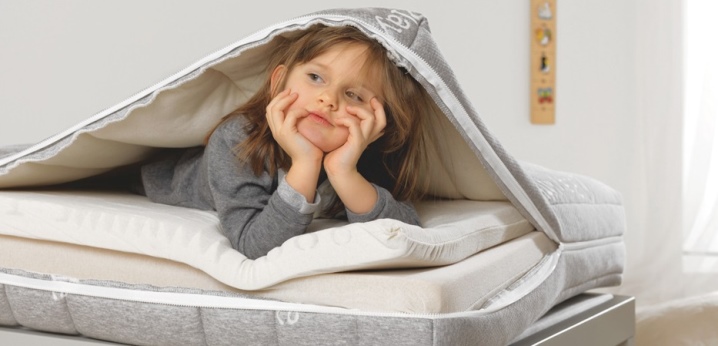
For a mattress to last a long time, you should take care of a moisture-resistant mattress topper made of non-slip fabric of natural origin. It is advisable to choose the option with antimicrobial impregnation or treatment with silver ions. Since the product is purchased for a long time, the color of the cover also matters. Despite the fact that removable covers can be removed and washed, covered with bedding, a colored mattress topper with a print is more practical.

How to make the mattress harder or softer?
In fact, it is very simple, because mattress manufacturers produce such mats, taking into account the interests of the user. These mattresses are called double-sided. They are a block with varying degrees of rigidity on both sides. It is made of one or two types of filler, supplemented with soft padding on one side. If you want to increase the rigidity, turn the mat with the hard side. When it is necessary to soften the surface of the block, turn it over the other side.
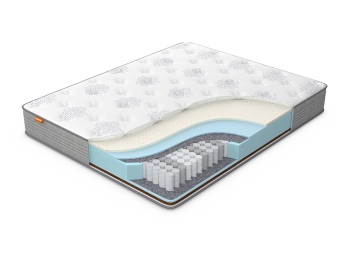
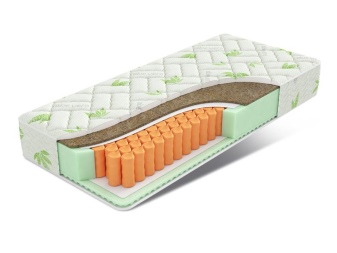
Structures with different stiffness of the sides are convenient in that, in addition to varying the degree of stiffness, they prevent the mat from caking, excluding its sagging and deformation. They are bought for children and adults, because sometimes a purchased mattress may not fit. In this case, a medium-hard type of surface will save the day, eliminate the need to return the mat to the seller, which is often problematic.
Reviews
Hard mattresses are recognized as a beneficial purchase for your health. This is evidenced by the reviews left on the forums dedicated to children's health and the sites of stores selling such mats. Rigid blocks are in high demand. Buyers note that sleeping on them is convenient and comfortable.
Opinions are mixed in choosing the firmness of mattresses. Some buyers, having tested the density of mattresses on themselves, note that they feel a difference in the thickness of the layer of coconut fiber, which should be more than 1 cm. Often they lack rigidity. Others strive to find a middle ground so that sleep is useful, and at the same time comfortable. Therefore, they are suspicious of monolithic mattresses.

As for rigid blocks, they are more often bought for children, as they are purchased taking into account the recommendations of pediatricians and orthopedists. Parents who care about the health of their children note that the sleep of babies on such mattresses is first accompanied by turning in search of a comfortable position, and then it becomes serene and prolonged. After getting enough sleep, children often wake up in a good mood and behave actively.
The following video will help you decide on the choice of this or that mattress.













The comment was sent successfully.